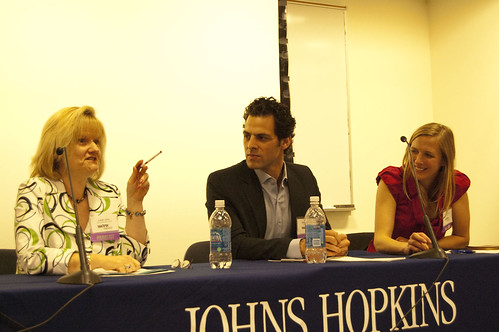WWPR Professional Development Recap: The Art of Story Telling: Selling Your Company, Your Product and Yourself Through Stories
Mar 23, 2011 | Professional Development
Panelist Cindy Atlee kicked off the WWPR March Professional Development Brown Bag, The Art of Story-Telling: Selling Your Company, Your Product, and Yourself through Stories, by having the audience choose a characteristic that describes themselves. This exercise was used to open up the discussion and to remind people that telling stories is the most interesting way to get your message across to your audience.  WWPR secretary Donna Savarese, director of communications, Innovative Solutions Group, moderated the panel following Atlee’s exercise; she set the tone for the luncheon with the question “What is a story, and how can it be used everyday?” Before letting the panel answer the question, she introduced the three building blocks of story telling: challenge, struggle and resolution. The panelists included:
WWPR secretary Donna Savarese, director of communications, Innovative Solutions Group, moderated the panel following Atlee’s exercise; she set the tone for the luncheon with the question “What is a story, and how can it be used everyday?” Before letting the panel answer the question, she introduced the three building blocks of story telling: challenge, struggle and resolution. The panelists included:
 WWPR secretary Donna Savarese, director of communications, Innovative Solutions Group, moderated the panel following Atlee’s exercise; she set the tone for the luncheon with the question “What is a story, and how can it be used everyday?” Before letting the panel answer the question, she introduced the three building blocks of story telling: challenge, struggle and resolution. The panelists included:
WWPR secretary Donna Savarese, director of communications, Innovative Solutions Group, moderated the panel following Atlee’s exercise; she set the tone for the luncheon with the question “What is a story, and how can it be used everyday?” Before letting the panel answer the question, she introduced the three building blocks of story telling: challenge, struggle and resolution. The panelists included:- Cindy Atlee, Partner, The Storybranding Group
- Nancy Belmont, CEO, Belmont Inc.
- Danny Harris, Founder, People’s District
- Add texture to your everyday stories
- Create the “WTF” moment
- Trigger people’s emotions
- Look at your brand as your external image
- You don’t have to tell an actual story to use the story mindset in communications Research your target audience through stories
- One experience for one person could be a completely different experience for someone else
- Begin at the end
- Form bonds with your story
- The power of the situation is increasingly important
- Humans have a need to create meaning—take advantage of that
- Don’t be afraid to use pictures
- Take people out of their everyday environment when interviewing
- Don’t completely resolve the story, but don’t leave your audience hanging either